Olympus E-3 Professional DSLR Introduction
The new Olympus E-3 is one of the most anxiously anticipated and speculated about cameras of the past few years. It’s been four years since the 5-megapixel Four Thirds System E-1 DSLR was introduced and Olympus E-System users have been very patient waiting for their new pro digital SLR. Tuesday nights it was finally unveiled, at an invite-only event at the American Museum of Natural History, in New York City. Olympus had 5 of their pro photographers on hand to answer questions about the new camera and show off some of the work they’ve done with it and plenty of E-3 DSLRs were on hand for people to play with.
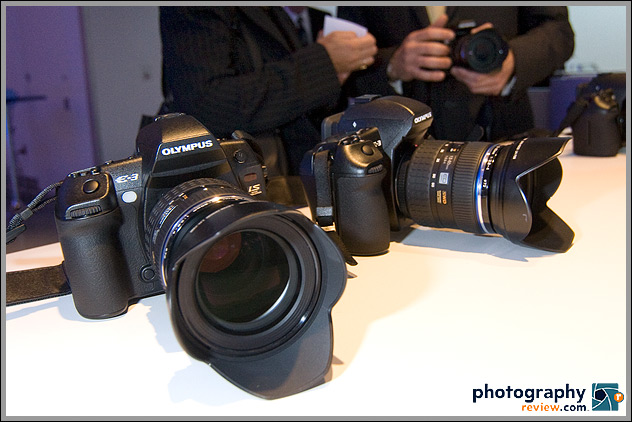
Noteworthy Olympus E-3 digital SLR features:
- A new 11-point auto focus array with the world’s fastest auto focus performance*
- Tilt/swivel LCD with Live View
- Rugged magnesium weather and dust-sealed body
- Sensor-level mechanical image stabilization
- TruePic III image processing
- Larger optical viewfinder with 100% field-of-view and 1.15x magnification
- Sensor dust-reduction system
- 150,000 cycle shutter with a maximum speed of 1/8000th second
- Separate processors for auto focus, image stabilization, and image processing
Hands-On Olympus E-3 DSLR Preview
Olympus had plenty of E-3 cameras with the new 12-60mm SWD lens available for the press to check out. I had an extra CompactFlash card with me so I have a bunch of E-3 sample photos to share with you. The first thing I noticed was how fast the new auto focus is. Olympus is claiming that the E-3 combined with their new Zuiko Digital ED 12-60mm f/2.8-4.0 SWD lens has the fastest auto focus currently available. It certainly feels like it could be the fastest, although controlled testing needs to be done. The camera is noticeably larger than the E-510 and has the sturdy solid build and professional feel that the E-1 had. It really feels and behaves like a professional digital SLR body.
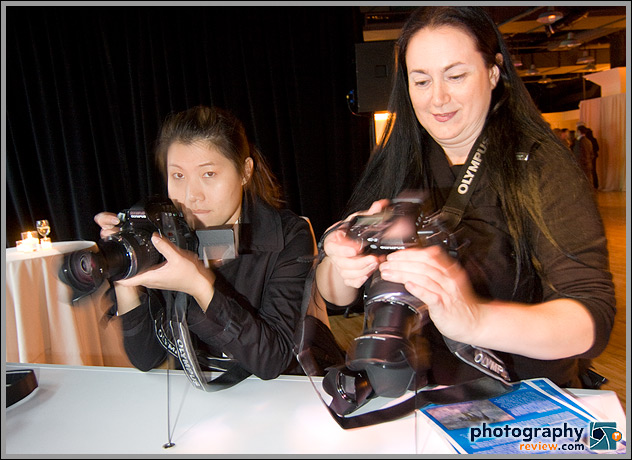
After the auto focus, the most noticeable feature of the E-3 is the tilt/swivel Live View LCD. The E-3 is the first DSLR to have both Live View and a fully articulated LCD display. Live View is a nice feature and it’s becoming standard on digital SLRs. But in my opinion, it’s not nearly as valuable if you can’t move the LCD so you can see it from other angles. I do a lot of tabletop product photography (pictures of cameras for our pro reviews) and I’m already dreaming about how the tilt/swivel Live View LCD will allow me to work more comfortably. It’s fully articulated so you can adjust it to any angle you want and it feels solid and moves smoothly.
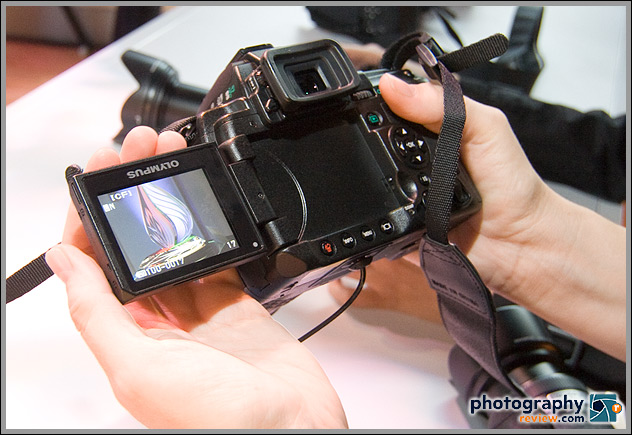
It’s a little early to judge the E-3’s image quality. But as I said, I did sneak a memory card into the camera for some early tests. Olympus will probably update the firmware before the camera is actually available so the tests I shot aren’t by any means definitive. But the new 10-megapixel sensor and TruePic III processing combined with the camera’s built-in mechanical image stabilization did a pretty good job in the less than optimum conditions at the introduction party. I wasn’t able to shoot any ISO 100 images and I was shooting at very slow shutter speeds. But taking a close look at the images I did shoot show excellent color and low noise. Everything was handheld and most photos were shot at ISO 400.
New Auto Focus System
As a photographer who shoots a lot of action, fast, predictable AF is one of the first things I look for in a digital SLR. Image quality is important, of course. But if I can’t get my subjects in focus, I might as well not be shooting.
The new auto focus system Olympus developed for the E-3 has 11-AF sensor points, each of which is the most sensitive cross-sensor type. Cross-sensor points used to be reserved only for the center focus point on digital SLRs. Using them across the whole array makes every AF point equally fast and accurate and allows the photographer to be more creative with composition in a wider variety of photographic situations. Whereas we may have reserved outside focus point use in the past for static subjects like landscapes, now those points can also be safely used for sports, wildlife, photojournalism, and any other situation where speed and accuracy are critical.
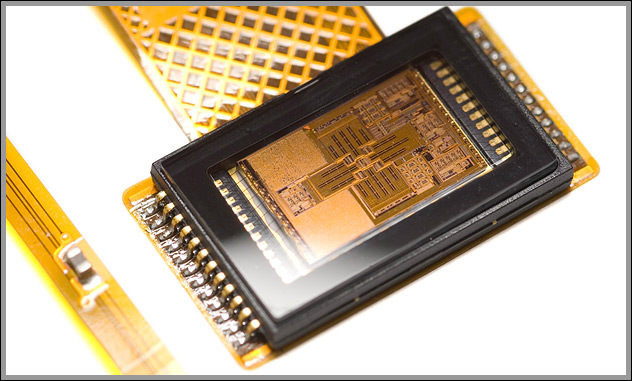
Besides using cross-type sensors for all AF points, Olympus has further increased the sensitivity and accuracy of their new system by layering “half-pitch” offset sensor arrays. Each Biaxial Cross Type AF sensor is actually comprised of two sets of four sensors – one at each point of the cross. And a layer below and slightly offset, another four sensors make up another cross. This ensures that even if the first, top level sensor doesn’t lock on the subject, the second sensor will.
While new sensor technology guarantees AF accuracy, dedicated AF processing and a new algorithm make AF speed as fast as possible. Olympus is claiming the new E-3 auto focus system, in conjunction with their new Zuiko Digital ED 12-60mm f/2.8-4.0 SWD (Supersonic Wave Drive) lens, is the fastest AF currently available.* Playing with the camera at the E-3 introduction, the auto focus was very quick and accurate. It’s fast enough that camera users immediately took notice and everyone who used the camera seems impressed.
Image Quality
There has been much concern, discussion, and speculation on the image quality potential of the Four Thirds sensor. Our own Laurence Chen wrote about this in his Olympus E-510 review. The Four Thirds sensor has less area than APS-sized sensors and smaller pixels generally mean reduced image quality. As you increase the resolution of a sensor, the individual pixels must get smaller. This isn’t just an issue for Four Thirds digital SLRs. It’s a challenge for any sensor standard. But since the Four Thirds sensor is smaller than other DSLR sensors, people have been particularly concerned. The new Olympus E-3’s new 10-megapixel High-Speed Live MOS Sensor demonstrates that things aren’t as simple as they seem. Olympus has addressed this problem by reducing the size of the data transfer circuitry around each pixel, allowing actually increasing the size of the pixel’s critical light-sensitive area. So even though the E-3’s sensor has the same resolution as the 10-megapixel E-510, its pixels have a larger capture area that collects better information.
Besides innovative sensor design, Olympus has also improved image processing. The TruePic III dedicated image processor reduces noise and ensures accurate colors and a wide dynamic range. The TruePic III processor is the same but the processing algorithm is new and Olympus claims it has further improved image quality. The increased data handling of a dedicated processor also makes the camera faster. The E-3’s capture rate has been increased to 5 frames-per-second, compared to other E-System bodies, which have a maximum rate of 3 FPS.
Feel & Reliability
You can read all about camera a camera’s design and build but there’s no replacement for actually having it in your hands. On paper, the E-3 is built to handle any event or environment. It’s weatherproof and dustproof and has a burly 3-piece magnesium metal chassis. And after using it last night, I can say that it feels as professional as the specs look. The camera feels solid and fit my hands well. All the controls seem to be in logical, easy to reach locations and it has two dedicated exposure control dials, like other pro DSLR bodies. There is nothing about the E-3 that stood out for me as weak, or poorly-placed. Like the E-1, the E-3 has a wonderfully, solid, complete feel. It’s larger than the E-1. But it’s also more powerful and built to an even higher standard. It even has a moisture and dust-proof pop-up flash!
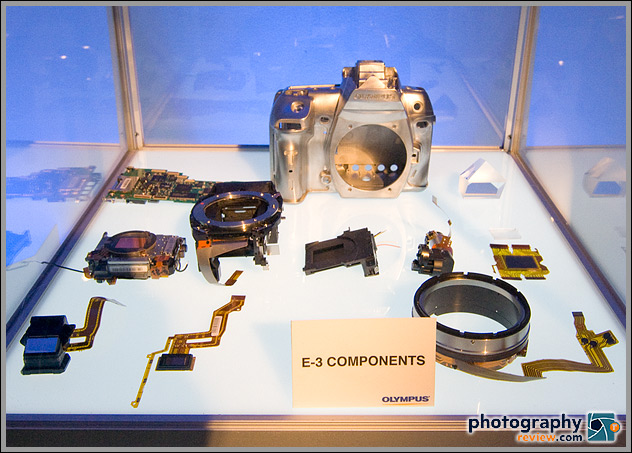
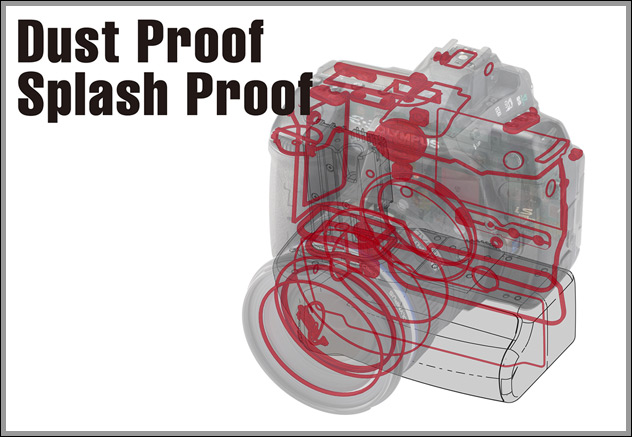
Conclusion
As I went over the E-3 specs and features I got more and more excited. And after having a little hands-on time with the E-3 at the introduction last night, I am even more convinced that Olympus has done it right. The camera feels solid and comfortable, initial performance is impressive, and the feature list is excellent with several important DSLR innovations. Photographers who waited for the E-3 digital SLR are being rewarded with a truly professional camera that should be able to compete with all but a few currently available digital SLRs. I really enjoyed playing with it and I’m looking forward to seriously testing the new auto focus system and the making controlled studio sample photos. Until then, we’re all still speculating. But so far, so good. It’s been a long time coming, but it appears that the new Olympus E-3 may have been worth the wait.
Olympus E-3 DSLR Preview Part II >>
Related Content:
Olympus E-3 Press Release >>
Read and Write Olympus Digital SLR Reviews >>
All Olympus Digital Camera Reviews >>
Olympus and Four Thirds Cameras Forum >>
Olympus Web Site >>
*The fastest auto focus claim is based on camera and lens combinations available in October 2007 and using the Olympus E-3 with the Olympus Zuiko Digital ED 12-60mm f/2.8-4.0 SWD lens.



Quote: “The E-3 is the first DSLR to have both Live View and a fully articulated LCD display.”
If I’m not mistaken that credit should go to Panasonic Lumix L10. While it’s not sold yet (may take 3 or 4 days), nor is it’s relative Olympus E-3.
Alex-
I stand corrected. It’s been a couple of months since the Panasonic L10 was announced and I’d forgotten about it. But I looked up the press release in our news section and you are quite correct. I will change my Olympus E-3 article so that it is accurate. Thanks for making me aware of my mistake. And thanks for reading the article!
Panasonic Lumix L10 was a revamped E-330, which had live view and articulated LCD. The L10, I believe had live view but no articulated LCD. Either way it is Olympus technology.
E3 Olympus ,we trust with Olympus I used the E10 the great for five years .and I think the E3 are the one of the great dig cameras in market.
Pingback: The National Park Foundation & Olympus 2008 Share the Experience Photo Contest
Owned one and love it. The setback is only on the battery life.
Any thoughts on the optional booster battery pack? Is it worthwhile? Does it add too much weight?
Ah… and if anyone wants to see a new take on the Olympus E-3, Jack Neubart just published a pretty favorable review on Photocrati. He seemed to like it a lot–though he didn’t test that battery pack booster!–and he does have some nice pic’s.